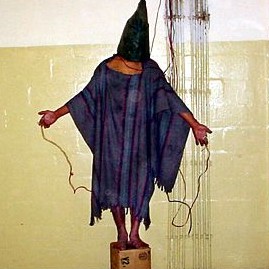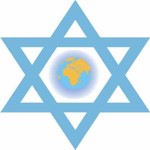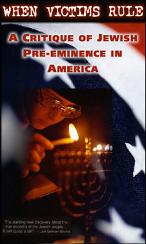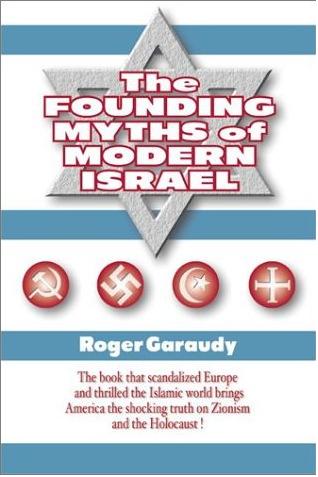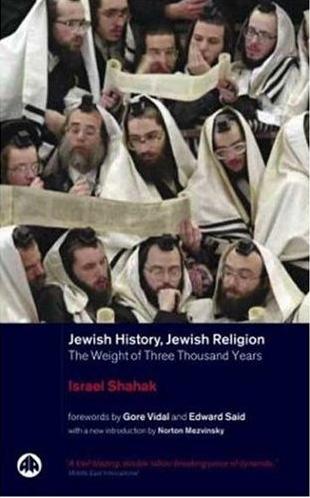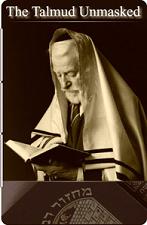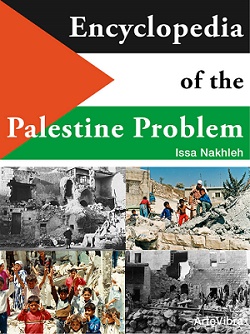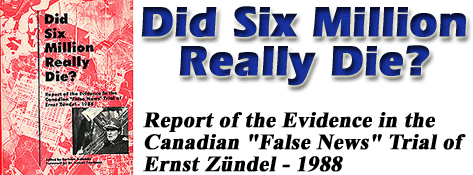
Thies Christophersen
[Thies Christophersen was the second witness called by the defence. He
testified on March 7 and 8, 1988.]
Thies Christophersen confirmed that he was the same Thies Christophersen
referred to on page 17 of Did Six Million Really Die? and that what was written
in the booklet was correct (20-4933).
Christophersen testified that as a member of the German army he was in Auschwitz
from January, 1944 to December, 1944 working at sub-camp Raisko growing Kok
Sagis, a type of dandelion which produced a white latex used in the production
of synthetic rubber. (20-4933, 4934, 4935)
As well as about two hundred women internees who lived at Raisko itself, the
work was done by women inmates from Birkenau, located about 2 km. away, and men
from the main camp of Auschwitz, located about 1 km. away. Christophersen
supervised their work. There were civilian employees as well (20-4937, 4938)
including Russian agronomists. (20-4942) Many of the internees were academics
who spoke German. (20-4960) Workers at Raisko worked in a greenhouse, a
laboratory, a garden and the fields. (20-4944, 4945)
The internees at Raisko were accommodated like soldiers in barracks. (20-4945)
There were about 70 internees per barrack. (20-4967) There were bunk beds, a
closet for each internee, running hot water and showers. Internees changed their
laundry once a week and every second week changed their sheets and linens.
In Birkenau, the accommodation was not as good. There were three bunks on top of
each other and internees did not each have a closet. (20-4945) He could not say
how many internees were in each barrack. (20-4967) Birkenau was overcrowded and
he felt sorry for the children of gypsies whom he saw playing there. (21-5008,
5009)
The inmates worked eight hours a day and after work walked back to Birkenau in
lines of three. Four to six SS guards accompanied the women. They were counted
when they arrived. (20-4939) The women comprised many nationalities, including
Poles, Russians, French, even Germans. (20-4939) Of the women that came from
Birkenau, he could not tell how many were Jewish, but thought perhaps half. (20
4940) There were also Jewish internees at Raisko. (20-4968) He got on well with
the Jewish workers. (20-4963, 4964)
While there was fraternization between the staff and internees at Raisko, which
resulted in one marriage while he was there, Christophersen did not think this
was possible at Birkenau. He did not know why, but stated that his superior at
Raisko, Dr. Caesar, was a very friendly and humane boss. Caesar was imprisoned
by the Poles for two years after the war. (20-4969)
At Raisko, mail was delivered to the internees. Parcels were opened in the
presence of the person who received them. Some things, such as money, drugs,
chemicals or propaganda material, were not allowed to be received. (20-4946)
Christophersen attended concerts in Auschwitz on Sundays where there was a
weekly concert held under the camp gate by internees who were professional
musicians. Anyone could listen to the concert who was walking around. (20-4960)
Mistreatment of internees was not tolerated and was punished severely but it
did, on occasion, happen. (20-4946) Christophersen himself saw an SS man kick a
prisoner and reported it. (20-4968) An order originating with Commandant Hoess
provided that the internees could talk to the commandant and this order was
posted. (20-4947) He never saw a prisoner die at Auschwitz-Birkenau, nor did he
believe the Jews were treated any differently from the rest of the prisoners. He
noted, however, that Jehovah's Witnesses were treated particularly well and were
not guarded. (20-4965) Internees who were sick returned to their work after
being away. (20-4966) Sports were played at all three camps by the internees.
(20-4968) Christophersen himself had friendly relations with the internees
(20-4938, 4965), and granted them permission at times to pick berries or
mushrooms or to swim in the Sola River. (20 4945)
Christophersen was never under any prohibition not to discuss things at Birkenau
with anyone in civilian life. (20-4965) Although he lived 500 metres from the
railroad to Auschwitz-Birkenau, he never noticed anything with regard to the
transports which struck him. (20-4964) His wife visited him frequently in
Auschwitz and that his mother also came. (20-4941)
Christophersen went to Birkenau perhaps twenty times in the entire time he was
at Auschwitz to get workers for Raisko or to fetch material from Kanada, the
storage place for internees' property. It was very difficult to obtain any of
this property and only pursuant to an authorization. (20-4945, 4946) Very often,
he would obtain material such as tubes for radios from the airplane detachment
division, which stored parts of crashed airplanes. (20-4948) On cross-examination, he agreed that in the first Zündel trial in 1985, he testified that
he had been in Birkenau about seven times. He reiterated, however, that he went
very frequently to the airplane disassembling plant, which was next to Birkenau.
(21-5003) He could go anywhere in the camp, as he was wearing the uniform of an
officer. During the times he visited the camp he would be there about an hour.
(20-4948)
Christophersen knew Birkenau had crematories and had seen them from the outside.
(20-4947) But he never saw smoke or flames shooting out of the chimneys nor did
he ever smell the alleged stench of human bodies. (20-4948) He did not know the
number of crematories. (21-5005) He only heard about the gas chamber allegation
after the war. (20-4949)
He saw Red Cross vehicles at Raisko in September of 1944. He watched them
driving towards Birkenau, but had no contact with them. (20-4966)
Although he was never informed of anything in the nature of atrocities to
internees when he was at the camp, Christophersen testified that his maid, a
Polish woman, once told his mother that there were corpses being burned at the
camp. Christophersen called the maid and asked her about the story, but she
couldn't give him any details. He got on his bicycle and toured around the
entire camp and inspected every fire location but found nothing. Christophersen
stated that today he knew that there were indeed corpses burned during the first
while. The corpses had been buried in the ground but because of the high water
level, it had to be discontinued. The corpses were dug up again and burned in
the open. He stated there were incredible stories told about this incident.
(20-4949, 4950)
Christophersen testified that the stories of six metre deep pits where corpses
were buried were impossible because of the water level at Birkenau. Although it
varied, depending on the water level of the Vistula and Sola Rivers, the water
level ranged from one metre to two metres. (20-4951)
There was a typhoid epidemic at Auschwitz-Birkenau that he was aware of. His
superior's wife died from typhus. (20-4949)
Horses were used almost exclusively in Raisko because of the scarcity of
gasoline. (20-4943)
Auschwitz was bombed once while he was still there, in perhaps September, 1944.
(20-4964
After the war, Christophersen was never questioned about his activities in
Auschwitz. He became a farmer in the area of Angeln. (20-4973, 4974)
He later wrote a book on his experiences, Die Auschwitz-Lüge (The Auschwitz
Lie.) Prior to publishing the book in 1973, he talked to his superiors about it,
including Dr. Caesar. They thought it was still too early and were afraid of
repressions. The book was later published in Spanish, French, Dutch, Danish,
Portuguese, English and German. (20-4950, 4951, 4961, 4970, 4975)
Zündel visited Christophersen twice to speak with him of his experiences.
(20-4961, 4979) On a visit by Zündel to Christophersen in around 1973, after the
publication of the book, Zündel requested the copyright. Christophersen
testified he gave the copyright to everybody, that he had made it publicly
available. (20-4935, 4936)
Zündel changed the title of the English language edition of the book to
Auschwitz: Truth or Lie. Christophersen did not add the parts of the book
dealing with Rudolf Hess, appeals for donations, or advertisements for the book
U.F.O's: Nazi Secret Weapon?. Christophersen thought Zündel published the book
in 1973, but he didn't know for sure. (20-4976, 4980; Auschwitz: Truth or Lie
entered as Exhibit 94, 20-4936) Other people had also published English language
editions of Christophersen's book, although he did not think the Institute for
Historical Review had ever done so. (20-4978)
The book was subsequently prohibited in Germany and Christophersen was convicted
of defaming the German Federal Republic. (20-4952, 4953) The charge provided
that the denial of mass gassings was an insult to survivors. (20-4971) He was 67
years of age when he served one year of a one and a half year sentence in 1985.
(20-4952, 4953) Notwithstanding its prohibition, the book continued to come into
West Germany from Switzerland and Denmark and was available in bookstores.
(20-4970) Because of a revision to the penal code in Germany, however, it was no
longer possible for Christophersen to tell of his experiences. (20-4972)
Christophersen had lived in Denmark for the past one and a half years because
there were no prohibitions there against books. (20-4973, 4974)
Asked if he was part of a conspiracy to rehabilitate Adolf Hitler and
re-establish National Socialism, Christophersen stated that he had absolutely no
political ambitions, but he definitely wanted to express his opinion for
persecutees and repressed people and minorities. In his opinion, today the Jews
were no longer persecuted, but Ernst Zündel was. (20-4963)
He believed the first time he spoke to Zündel was in 1973. (20-4981) He visited
Zündel in 1979 and at that time spoke to some people Zündel had invited about
his experiences in Auschwitz. (20-4980, 5068) He thought it was possible that in
1973 Zündel found the gas chamber story to be unbelievable and that was why he
wanted to publish Christophersen's book. He pointed out, however, that the book
did not deal with gas chambers as such, but was a counter-representation to the
atrocity stories. (20-4981) The only part which dealt with the gas chambers was
a foreword written by Manfred Roeder. (20-4982)
Christophersen, asked if he denied there were gas chambers at Auschwitz, replied
that he had not found anybody who could give him details about the gas chambers
although he had made efforts to do so. (20-4982) He had read the book by Kogon,
Langbein and Rückerl, Nationalsozialistische Massentötungen durch Giftgas
(National Socialist Mass Killings Through the Use of Poisonous Gas), a book
which he saw as an attempt to bring many different statements or opinions into
one line. (21-5091) He knew Kogon was a professor, and that Langbein had been
interned at Auschwitz and spent his time there working in an office. Rückerl was
the head of an institute in Germany. (21-5092)
Christophersen had also distributed Did Six Million Really Die?. He saw the
booklet as a counter-representation. On the one hand, he said, "we hear all
these terrible lies, soap and lamp shades from human beings and those burnings
in ditches," and on the other hand, there was the Harwood publication which, in
his opinion, was more credible. (20-4962, 4963)
On cross-examination, Crown counsel pointed out that Did Six Million Really Die?
quoted Christophersen as having written that:
• "...In the vicinity of the main camp (Auschwitz I) was a large farrier's
works, from which the smell of molten iron was naturally not pleasant."
Christophersen agreed this was incorrect. What he had written was that it was
not molten iron that created the stench, but the horn of the horses' feet at a
smithy's work.
The Crown quoted from page 5 Auschwitz: Truth or Lie?:
The leading Austrian Social Democrat, Dr. Benedikt Kautsky - himself a Jew - who
spent the years from 1938 to 1945 in concentration camps, three of these in
Auschwitz, said: "I was in the big concentration camps in Germany. I must
truthfully state that in no camp have I ever seen anything that might have
resembled gas chambers."
Christophersen agreed that the same quote appeared in Did Six Million Really
Die?. (21-5041) The Crown showed Christophersen the 1948 edition of the Kautsky
book (it was the 1946 edition which was quoted in Did Six Million Really Die?),
and read him the following quotation:
I would like to include here a short description of the gas chambers which I
have, it is true, not seen myself, but which was described by me by so many
different parties in a credible fashion that I am not afraid to render the
description here.1
Christophersen stated he obtained the quote from a source known to him; he had
tried very hard to get the Kautsky book but could not find it anywhere. Accused
of printing a quote from a book he had never read, Christophersen replied that
he had done so frequently, even quotes from the Bible. He agreed, that,
"naturally," he had quoted it because it supported his position. (21-5045) Asked
if he quoted half of the quote because the whole quote didn't support his
position, Christophersen stated he did not know the other half. (21-5046)
Christophersen wrote the synopsis of the Red Cross Report which appeared on page
11 of his book. He received the information from a reliable source, Dr.
Stäglich, but noticed after publication that the synopsis contained a small
mistake. (21-5043, 5044, 5045) He agreed that it was very important to check
sources before publication but pointed out that he had corrected it in later
editions of his book. He had also published correspondence between Dr. Stäglich
and the Red Cross. (21-5051)
Christophersen agreed that in his synopsis he stated that the Red Cross delegate
made a "careful inspection" and that nowhere in the report of the delegate did
it say a "careful inspection" was made. In Christophersen's opinion, the
delegate's claim that he was only at the door of the commandant was not true;
the delegation had been at Raisko and also in Birkenau. (21-5052 to 5059) He
himself had seen the vehicles at Raisko and watched them drive in the direction
of Birkenau. He had heard later in the officer's mess that they also visited
that camp. (21-5082, 5083) The delegate did not have the courage to say the
truth; perhaps he expected repressions and punishments. (21-5052 to 5059)
Christophersen agreed that in the previous Zündel trial in 1985 he answered "no"
when asked if he knew where the Red Cross went after they left Raisko. He saw no
contradiction between the answers. (21-5083, 5084)
Christophersen agreed that on page 4 of his book he had written:
In 1938 there were supposed to be 15,688,259 Jews in the world. This figure is
derived from the "World Almanac" of the American Jewish Committee. In 1948,
according to an article in the New York Times by W. Baldwin, there were supposed
to be 18,700,000 Jews in the world. Baldwin is a well-known population expert,
entirely neutral, and even the most far-fetched imagination could not describe
him as "anti-semitic."
Christophersen obtained this information from a Mr. Einar Aberg in Sweden, who
informed Christophersen that he had published it for several years without the
information being contested. On the basis of that, Christophersen believed he
could do the same thing; that as a journalist, that was sufficient.
Christophersen pointed out that the Crown had not read the sentence in the book
which clearly stated that the information came from Aberg. (21-5061 to 5063)
Christophersen had checked the figures in an encyclopedia. He agreed that the
figures used were the same ones used in Did Six Million Really Die?. (21-5064)
Christophersen agreed that on page 4 of his book he had written:
The losses of the Jewish people during WW II, certainly regrettable, were not 6
million, but approximately 200,000, according to facts compiled by the UNO,
which body surely has no reason to grant special protection to any one nation in
particular.
This paragraph, said Christophersen, referred to a United Nations report he had
received about 15 years before. He tried to have the figure confirmed by letter
but received no reply. He took no answer as an answer. (21-5065)
Christophersen agreed his book contained the following statement:
A book published in Brazil contains the following statement: "...These facts
were used by the Canadian Anti-Defamation Committee of Christian Laymen in
ascertaining that 200,000 Jews died in the twelve years of Hitler's rule
(1933-45), regardless of how they died, i.e. whether they were killed, sentenced
and shot as guerillas or saboteurs, or in air raids on camps, or through other
circumstances due to war, including sickness and old age."
Christophersen testified this quote came from a book by Juan Maler in Brazil. He
did not know what the Canadian Anti-Defamation Committee of Christian Laymen
was, and would have to ask Mr. Maler. He agreed he published a statement that he
read in a book without checking it. (21-5067)
The Crown read the following passage from Christophersen's book at page 19:
The Jews were intelligent and so far as I got to know them in Auschwitz, quite
nice too. In the summer my mother came for a visit and stayed several days. Of
course, a fat friendship developed between her and Olga. One evening my mother
asked about the crematorium where corpses were supposed to be burned. I knew
nothing about this, so I asked Olga. She could not tell me anything definite
either. She did intimate, however, that around Bielitz there always was what
seemed to be a reflection against the sky, as if from a fire.
So I went in the direction of Bielitz and there found a mining camp in which
some inmates also worked. I travelled around the entire camp and examined all
fire grates and all smoke stacks, but found nothing. I asked my colleagues; the
answer... a shrug of the shoulder and "don't pay any attention to those rumors."
Pearson suggested to Christophersen that he never went to Birkenau.
Christophersen denied this, stating that this edition was written differently
from his original German edition. (21-5105, 5106) On re-examination, he
testified that where the excerpt spoke of "the whole camp," he was speaking of
the entire camp complex, Auschwitz I with the surrounding plants, Birkenau, the
aircraft disassembly plant, and an industrial plant. (re-ex., 21-5111, 5112)
Christophersen preferred the word "internees" rather than "prisoners" to
describe the inmates of the camps. There was a difference: "prisoners" were
jailed in a cell while the "internees" could move around freely and were able to
work. (21-5085) The internees were paid in something like camp money. (21-5085)
When he went to Birkenau to get workers, Christophersen would ask who wanted to
do the work. Mainly Polish people would volunteer for agricultural labour
because they wanted to do that type of work. Asked if these people were used as
slave labour, Christophersen pointed out that during the war, everybody had to
work, to do their duty and in that way all were slaves. (21-5087)
The Jewish internees wore a yellow star. Other triangles worn by the internees
included red for political prisoners, pink for homosexuals and violet for the
Bible Researchers (Jehovah's Witnesses). (21-5089)
Asked if race was important to the Nazi regime, Christophersen stated that it
was important not just for Adolf Hitler but also for Israel since the latter
country, upon its establishment, took over the Nuremberg race laws. (21-5088)
The Jews were internees in Germany, just as Germans were internees in Canada.
International Jewry had declared war on Germany. It wasn't taken very seriously
at the time because no state of Israel existed, but when the war grew hotter,
the members of this enemy state, International Jewry, were interned.
Christophersen knew they were innocent people but believed the internment was
necessary. He could not say "justified" as the whole war was not just. (21-5089,
5090)
Christophersen met Adolf Hitler twice. The first time, as a young man, he had
seen Hitler give a speech at Nuremberg and had thereafter gone to have his lunch
outside under an apple tree. Three vehicles which were passing by came to a stop
and out of one of the cars came Hitler. He and Christophersen had a conversation
about Christophersen's farm and the type of cattle and pigs they were breeding.
Christophersen was amazed at his knowledge of agriculture. Hitler wrote down his
address and invited him to his birthday on the 20th of April. On this occasion,
Christophersen met Hitler again. A year later, in 1938, he again went to
Hitler's birthday celebrations to bring greetings from his area,
Schleswig-Holstein. These meetings had a substantial impact on Christophersen
and he was emotional talking about it. (21-5094) When Christophersen married, it
was on the 20th of April. (21-5107)
Christophersen agreed that he told his audience in New York in 1979 that to him,
Adolf Hitler had always been and still was the greatest person whom history had
brought forth in the last 2,000 years and not only for the Germans. He saw
Hitler as a saviour, not only for himself but also for six million other
unemployed Germans. Hitler performed wonders and Germans loved him. The high
point of Christophersen's life came in 1937 when he was able to hold a lengthy
conversation with Hitler. (21-5107 to 5110)
On re-examination, Christophersen testified that sympathy for National Socialism
was not a justification for lying. His motives for testifying were as follows:
he had come to the conviction that the gas chamber stories were a hoax, a
swindle. He admitted he was not a scientist or a historian, but he felt like the
child in the fairy tale who pointed out that the emperor had no clothes.
Professor Hilberg collected everything that served his thesis and Christophersen
would collect and publish everything that served his. Every criminal had a right
to defend himself, and he wanted the same right for his people who were
represented as a criminal people. (21-5114, 5115)
Asked if he was so emotional about Hitler that he could not tell the truth,
Christophersen replied that people who had been very enthusiastic about Hitler
denied him from one day to the other. People were usually inclined to applaud
the victor. He didn't do that. He could not say Hosanna one day for Adolf Hitler
and crucify him the next. Those who lived through the Hitler times and
experienced the enthusiasm of those years would never, if honest, forget those
times. (21-5115) But he would not tell lies for Adolf Hitler. (21-5116)
When visiting North America in 1979, Christophersen gave speeches in various
cities, Toronto, New York, Chicago, on a tour organized for him. He could not
remember who organized it. (21-5095) He believed Matt Koehl was an organizer for
something later, but he could also have helped organize the 1979 tour. (21-5096)
Christophersen was shown the newspaper White Power: The Revolutionary Voice of
National Socialism, April 1979 edition, and stated that he saw the name "Matt
Koehl," and assumed it was the same person, but pointed out there was no
photograph of the man. (21-5096) Christophersen had seen the newspaper before.
It was sent to him occasionally. (21-5098) He knew the newspaper advertised his
book; the advertisement in this particular edition advertised the book as
Auschwitz: Truth or Lie which Christophersen agreed was the title under which
Zündel published the book. (21-5099) Christophersen did not think he asked for
his book to be advertised there. The newspaper didn't get the books from him, it
must have gotten it from either Mr. Deitz or Zündel. He could read enough
English to make out the titles of the advertisements and his name. (21-5112,
5113) Also advertised in this edition were the books Six Million Lost and Found
(formerly published as Did Six Million Really Die?), Drama of the European Jews
by Paul Rassinier, The Hoax of the Twentieth Century by Prof. Arthur Butz, and
Mein Kampf by Adolf Hitler. Christophersen also identified the title
Auschwitz:
Truth or Lie in the "Worldwide Bibliography of 'Holocaust' Revisionism"
published in the IHR Special Report on the Holocaust. (21-5100, 5101)
Christophersen pointed out that his books were being advertised and spoken of
positively in other media which were not National Socialist in viewpoint.
(21-5100) White Power filed as Exhibit 96; 21-5104)
Note
1. Not compared with original.
 | The
concepts expressed in this document are protected by the basic human
right to freedom of speech, as guaranteed by the First Amendment of the
Constitution of the United States, reaffirmed by the U.S. Supreme Court
as applying to the Internet content on June 26, 1997. |
 |






























